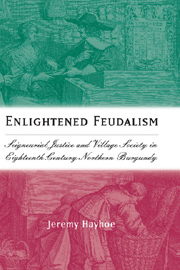 Enlightened Feudalism
Enlightened Feudalism Book contents
- Frontmatter
- Contents
- List of Illustrations
- Preface
- Introduction
- Part 1 Seigneurial Justice in Practice
- Part 2 The Winds of Change
- Conclusion: Lords, Judges, and the Self-Regulating Village
- Appendix A Police Regulations from the Assizes during the 1780s
- Appendix B Class Justice? Statistical Tests
- Notes
- Bibliography
- Index
Appendix B - Class Justice? Statistical Tests
Published online by Cambridge University Press: 12 September 2012
- Frontmatter
- Contents
- List of Illustrations
- Preface
- Introduction
- Part 1 Seigneurial Justice in Practice
- Part 2 The Winds of Change
- Conclusion: Lords, Judges, and the Self-Regulating Village
- Appendix A Police Regulations from the Assizes during the 1780s
- Appendix B Class Justice? Statistical Tests
- Notes
- Bibliography
- Index
Summary
The following tests are designed to bring some statistical rigor to the question of whether seigneurial courts in northern Burgundy administered a kind of class justice, basically allowing the wealthy to sue the poor. Plaintiffs and defendants in the fourteen seigneurial courts studied were matched to their tax assessments, which were then used as a proxy for wealth levels. These assessments of plaintiffs and defendants were then subjected to a paired t-test. The null hypothesis in all cases was that the mean tax assessment (and so, approximate level of wealth) of plaintiffs was significantly different from the mean tax assessment of defendants (that on average, plaintiffs were from a significantly different social stratum than defendants). In all cases the test results indicated that the null hypothesis should be rejected. There was, in other words, no significant difference between the wealth levels of plaintiffs and defendants.
The graphs that follow the statistical tests can be used more impressionistically to show the same thing. These graphs present the tax assessments of defendants plotted against the assessments of plaintiffs, with each point representing one court case. A class-justice model would lead us to expect the points to be clustered in a vertical line toward the high end of the x-axis (plaintiffs). In fact, there is little pattern, although many of the points are lower than the average assessments (of about 20 livres), and most are lower than 40 livres for both plaintiffs and defendants.
- Type
- Chapter
- Information
- Enlightened FeudalismSeigneurial Justice and Village Society in Eighteenth-Century Northern Burgundy, pp. 223 - 228Publisher: Boydell & BrewerPrint publication year: 2008


